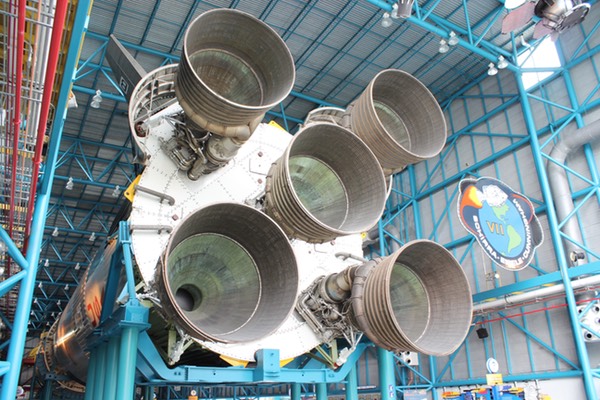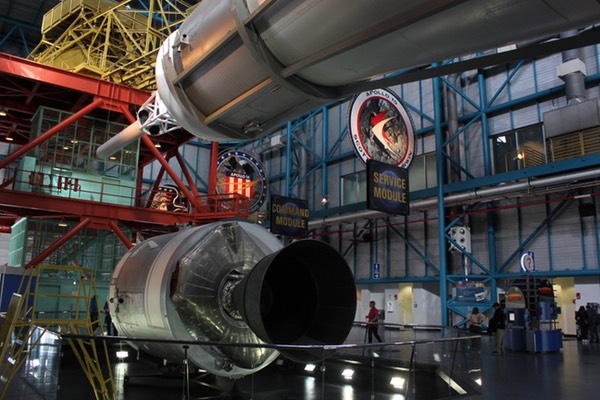Remembrance of things pastby Dwayne Day
|
| Florida’s central east coast has an environment that is not conducive to long-term preservation of metalwork, or in fact virtually any manmade structure. This is not deliberate destruction, it is oxidation. It is entropy on fast forward. |
“Where's the difference?” Mr. French asks. Let’s start with the rather obvious fact that what ISIL has been doing in the Middle East is deliberately destroying cultural and historical sites and artifacts, many of which have survived for thousands of years. They do this in the service of a medieval philosophy that values little beyond their own power. The human toll taken by these barbarians is significant and sickening and dwarfs their focused cultural destruction, but their cultural vandalism is nevertheless tragic. To compare all that to “neglected metalwork” in Florida is nonsense.
Florida’s central east coast has an environment that is not conducive to long-term preservation of metalwork, or in fact virtually any manmade structure. It is hot, humid, and salty, a corrosive combination that dissolves metals and destroys many other materials. Structures that are not actively maintained—which costs money—will rapidly deteriorate. This is not deliberate destruction, it is oxidation. It is entropy on fast forward.
The people who live and work and maintain structures at the Kennedy Space Center and adjacent Cape Canaveral Air Force Station experience this environment daily and they know what it can do. As a result they have developed materials (like anti-corrosion paints) and techniques for minimizing nature’s impact and increasing the longevity of structures in this harsh environment. But more importantly, they have developed procedures and policies to follow to determine what to do with facilities over time.
When a facility is no longer needed for its current purpose, NASA (and Air Force) property managers evaluate whether it can be used for some other current purpose. If not, they determine whether that structure should be preserved for future near-term use. If so, they have to maintain the environmental systems and keep the structure sealed and protected: turn off the air conditioning in a building at Cape Canaveral and, within a year or two, it may be overtaken by toxic mold. Fail to keep it properly sealed and animals—some of them dangerous—can move in. Facilities management experts are fully aware of this.
That leaves the question of what to do if a facility has no further practical use but is historically significant. In most cases it is too costly to preserve such structures. In that event they are documented through photographs and other means, historical items can be removed, and the structures are either demolished or abandoned in place if demolition costs are high. But there are regulations requiring this and procedures that the people who manage these facilities follow. This is certainly not historic vandalism; it is not even neglect. It is historical stewardship, and management, based upon careful prioritization and fiscal prudence.
| Those advocating “save everything” have no understanding of just how much that costs, and no responsibility for actually doing it. |
There are numerous examples at Cape Canaveral where NASA and the Air Force have preserved substantial historical infrastructure at considerable cost and effort. A launch control bunker has been maintained on Cape Canaveral Air Force Station. Consoles from one of the Apollo-era firing rooms have been preserved as well. Even windows from one of the firing rooms have been incorporated into a relatively new building on the facility in order to honor the past.
Mr. French’s article included a photo of the LC-34 launch pad, which was stamped “ABANDON IN PLACE” many years ago (and which somebody modified to read “ABANDON IN PEACE” in memory of the Apollo 1 crew). LC-34 is actually owned by the Air Force and could be a future commercial launch site. It is in relatively close proximity to the active LC-37, 40, and 41 pads. The fact that the Air Force allows public tours to visit LC-34 is itself a sign of the respect that the service has for what occurred there in January 1967.
The metalwork at LC-34 and other launch structures, such as the Redstone, Mercury, and Saturn pads, could not be preserved because the cost of doing so would have been very high, and requirements to hurricane-proof them drive costs up even higher. But when they could, NASA and the Air Force saved structures, such as the blockhouse at LC-14 used for launching John Glenn’s mission, which is now a conference center, or one of the white rooms from Gemini. Surprisingly, NASA and its partners even managed to find a way to save portions of the Launch Umbilical Tower from the Apollo missions, including part of the top of the tower and its crane as well as the access arm used by the astronauts to reach their spacecraft, moving it indoors when the easiest and most cost effective course of action would have been to scrap these things. Those advocating “save everything” have no understanding of just how much that costs, and no responsibility for actually doing it. Comedian Steven Wright once quipped that you can’t have everything. “Where would you put it?” he asked in his trademarked deadpan voice. It is not practical to save everything, so it is imperative to save the most important things.
 (credit: D. Day) |
It should go without saying that the most historical space artifacts are those that have actually flown in space. Of lesser historical importance are those, such as backup space hardware, that were intended to fly but never did, and can serve as historical reference, educational tools, and inspiration. Below those items in importance—quite far below in fact—are the ground facilities that have alternative uses and relatively limited connection to the actual activities themselves. They are also the most difficult and expensive things to preserve; you cannot move a launch control bunker to a museum, and it may occupy a remote piece of real estate that has valuable uses.
Considering this prioritization hierarchy, the United States has a truly impressive record at preserving its space artifacts. All three flown space shuttles are currently on display indoors and protected from the elements, as is the first shuttle test article. All flown piloted Apollo, Gemini, and Mercury spacecraft are also preserved. There are three huge Saturn V rockets—two of them actual flight hardware—in climate controlled indoor display areas. The United States government, often in partnership with private companies, took the biggest rockets ever built, and erected large buildings to house them and preserve them—a substantial expenditure that is unmatched by any other country for its aerospace heritage. This leftover unflown space hardware could have been scrapped, and significant money saved, but they were kept for future generations.
| One suspects that if Proust stood in an American museum and looked at a Moon rock or a spacecraft he would understand why it was there and the memories it was intended to preserve and revive, and their role in supporting “the vast structure of recollection.” |
That space hardware and many other objects, such as unflown robotic spacecraft, are on display at numerous museums in Houston, Huntsville, Washington DC, Los Angeles, New York City, Seattle, Chicago, Dayton, and even the middle of Kansas. There is no way to walk into the magnificent Apollo-Saturn V Center at the Kennedy Space Center and not only be impressed by the rocket it contains, but the sheer scale and effort—and money—that went into that facility. It is a shrine to American achievement, complete with its own stirring symphonic score.
The statement about ISIL was the most egregious one in the article, but it was not the only one. There was also this: “At least in Russia the authorities tout Soviet space achievements and the associated museum-housed hardware with the respect it deserves, if not the official recognition of its status.” The sentence is awkward—what does it mean that Russian authorities “tout Soviet space achievements… with the respect it deserves”? But the modifier “at least” is clearly intended to establish another comparison leading to the obvious conclusion that “Russian authorities” are better than American ones when it comes to honoring their space heritage. Considering that the author previously compared American space property managers to terrorists, this is a rather benign sentiment. But it is still ridiculous.
Perhaps the author has missed the numerous photographs posted on the Internet showing the abandonment of various pieces of Soviet era space hardware like the Buran shuttles or the Energia-M. There are no Russian N-1 rockets preserved, nor are any Energia rockets saved for future generations. Good luck taking a bus tour of Baikonur or Plesetsk, or visiting a major Russian space museum outside of Moscow. Perhaps the author is also unaware of the way a great deal of Soviet era space hardware was treated particularly during the 1990s. Iconic artifacts like Yuri Gagarin’s capsule have been preserved and displayed, but some Russian spaceflight hardware was sold and currently resides in American museums, where, ironically, it is treated with respect by the Soviet Union’s former adversaries. One can walk into the Smithsonian National Air and Space Museum in downtown Washington, DC and see on display a mockup of Sputnik in the “Milestones of Flight” gallery, the most prominent location in the museum. Walk down the hall and you can see a mockup of a Soyuz spacecraft, as well as flown Soyuz and TKS capsules, spacesuits and other artifacts.
The United States is a wealthy country and it is no surprise that it has done such a great job of preserving its own space history, and not even a surprise that it has helped to preserve some of the Soviet Union’s space history as well. Russia has less money for non-essentials—and museums are a luxury when your economy is in bad shape—but even so, the Russian government’s record at historical preservation of the country’s proud aerospace history is not particularly shining. Even now there is growing concern within Russia that the large air force museum at Monino is about to be closed and many of its prototype aircraft may be destroyed.
Proust, in his novels, was not thinking of large things like Moon rockets, or even in sweeping historical terms like the achievements of governments and their agencies. His concern was with the small and the personal and their connections to memories long forgotten. But one suspects that if he stood in an American museum and looked at a Moon rock or a spacecraft he would understand why it was there and the memories it was intended to preserve and revive, and their role in supporting “the vast structure of recollection.”
